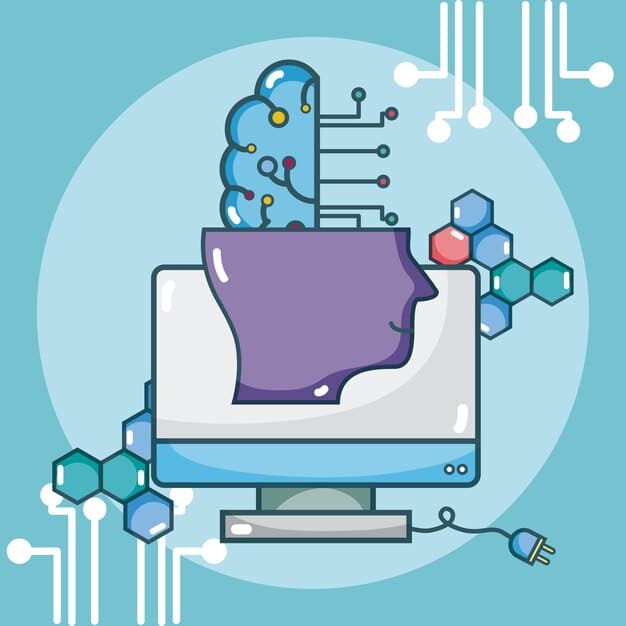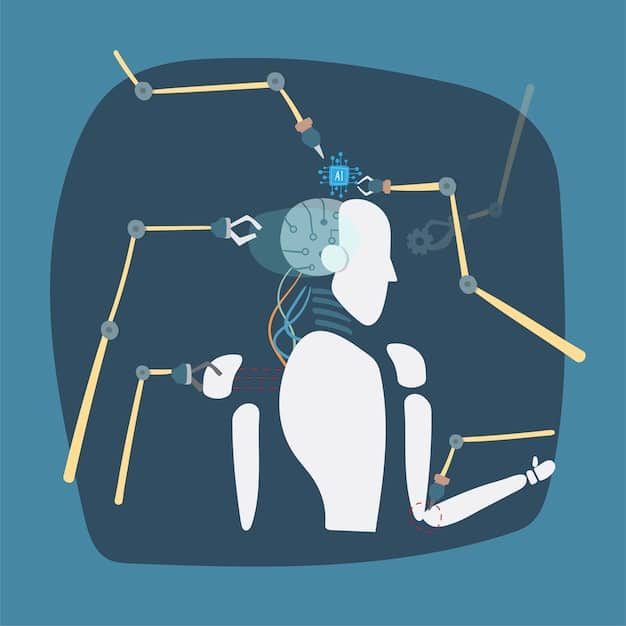Brain-Computer Interfaces: Enhancing Humans & Treating Disorders by 2040

Brain-computer interfaces (BCIs) are set to revolutionize human life by 2040, offering enhanced capabilities and innovative treatments for neurological disorders through direct communication pathways between the brain and external devices.
Imagine controlling your computer with your mind, or restoring movement to paralyzed limbs. Brain-computer interfaces: How BCIs Will Enhance Human Capabilities and Treat Neurological Disorders by 2040? holds the key to unlocking these possibilities within the next two decades.
The Dawn of Brain-Computer Interfaces
Brain-computer interfaces (BCIs) are poised to transform how we interact with technology and treat neurological conditions. These systems create a direct communication pathway between the brain and external devices, bypassing traditional routes like muscles and nerves.
By 2040, BCIs are expected to be more sophisticated, accessible, and integrated into our daily lives. This has transformative implications for healthcare, human augmentation, and even entertainment.

Understanding the Basics of BCIs
At its core, a BCI system involves several key components:
- Signal Acquisition: Sensors detect brain activity, such as electrical signals (EEG), magnetic fields (MEG), or neural firing patterns.
- Signal Processing: Algorithms filter, amplify, and translate brain signals into commands.
- Device Control: The processed signals control external devices or software applications.
- Feedback: Users receive feedback from the device, allowing them to refine their control and learn to use the BCI effectively.
Current BCI technologies range from non-invasive methods like EEG caps to invasive methods that involve implanting electrodes directly into the brain. The choice of method depends on the desired level of precision and the specific application.
By understanding the underlying principles of BCIs, we can start to appreciate the vast potential of this technology to revolutionize various aspects of human life.
Enhancing Human Capabilities with BCIs
One of the most exciting prospects of BCIs is their ability to augment human capabilities. Imagine enhancing cognitive functions, improving motor skills, or expanding sensory experiences through a direct interface with the brain.
By 2040, BCIs could offer a range of enhancements that redefine what it means to be human.
Cognitive Enhancement
BCIs have the potential to boost cognitive functions such as memory, attention, and learning. By stimulating specific brain regions or providing real-time feedback on cognitive performance, BCIs could help individuals optimize their mental abilities.
Imagine using a BCI to:
- Improve focus and concentration for tasks requiring sustained attention.
- Enhance memory retention and recall for learning and problem-solving.
- Increase processing speed and decision-making accuracy in complex situations.
These cognitive enhancements could have profound implications for education, professional performance, and overall quality of life.
Such advancements promise a future where cognitive limitations become relics of the past, unlocking human potential across various domains.
Treating Neurological Disorders with BCIs
Beyond enhancing human capabilities, BCIs hold immense promise for treating neurological disorders. These devices can bypass damaged neural pathways, restore lost functions, and even alleviate symptoms of various conditions.
By 2040, BCIs are expected to be a mainstream treatment option for a range of neurological disorders, offering new hope to patients and their families.

Restoring Motor Function
One of the most promising applications of BCIs is restoring motor function in individuals with paralysis or motor impairments. By decoding brain signals related to intended movements, BCIs can control prosthetic limbs or stimulate muscles to perform desired actions.
Consider the possibilities:
- Paralyzed individuals regaining the ability to walk, grasp objects, and perform daily tasks.
- Stroke patients recovering motor control through targeted BCI-assisted therapy.
- Individuals with spinal cord injuries regaining independence and mobility.
These advancements could dramatically improve the quality of life for millions of people affected by motor impairments.
BCIs promise a future where motor limitations are overcome, empowering individuals to live fuller, more independent lives.
The Ethical and Societal Implications of BCIs
As BCIs become more powerful and prevalent, it is essential to consider the ethical and societal implications of this technology. Issues such as privacy, security, and equitable access must be addressed to ensure that BCIs are used responsibly and for the benefit of all.
By 2040, proactive measures may be necessary to address concerns relating to BCIs.
Addressing Privacy Concerns
BCIs can access and interpret brain activity, raising concerns about the privacy of thoughts and intentions. Safeguarding individuals’ neural data is crucial to prevent misuse or unauthorized access.
We should consider the following:
- Developing robust encryption and security protocols to protect neural data.
- Establishing clear guidelines for data collection, storage, and sharing.
- Empowering individuals with control over their neural data and how it is used.
Addressing these privacy concerns will be essential for building public trust in BCI technology and ensuring responsible development.
Privacy in brain activity is paramount to BCIs, as neural data management is critically important to keep society safe.
The Future of BCI Technology
The field of brain-computer interfaces is rapidly evolving, with ongoing research and development pushing the boundaries of what is possible. From new materials and sensing techniques to advanced algorithms and control strategies, innovation is driving BCIs towards a future of enhanced capabilities and broader applications.
Envision possibilities that might be available by 2040.
Technological Advancements to Anticipate
Several trends are shaping the future of BCI technology:
- Non-Invasive BCIs: Developments in non-invasive sensing techniques, such as advanced EEG and fNIRS, could enable more user-friendly and accessible BCIs.
- Wireless BCIs: Wireless communication technologies could eliminate the need for cumbersome wires and cables, improving user comfort and mobility.
- AI-Powered BCIs: Artificial intelligence (AI) algorithms can enhance signal processing, decode complex brain patterns, and personalize BCI control strategies.
- Closed-Loop BCIs: Closed-loop systems that provide real-time feedback to the brain could enhance learning and adaptation, leading to improved BCI performance.
These technological advancements promise to make BCIs more powerful, versatile, and integrated into our daily lives.
As BCI technology converges with other cutting-edge fields, we can anticipate even more revolutionary applications and possibilities in the years to come.
Preparing for the BCI Revolution
As brain-computer interfaces become increasingly prevalent, it is essential to prepare for the profound changes they will bring to society. Education, awareness, and open dialogue are crucial for ensuring that BCIs are used responsibly and for the benefit of all.
We should be able to anticipate this quickly approaching BCI future.
| Key Point | Brief Description |
|---|---|
| 🧠 BCI Basics | Direct communication between brain and device. |
| 🚀 Capability Enhancement | Boosting cognitive functions like memory. |
| ⚕️ Treating Disorders | Restoring motor function in paralysis patients. |
| 🛡️ Ethical Implications | Addressing privacy and security concerns. |
Frequently Asked Questions About Brain-Computer Interfaces
▼
A BCI is a system that establishes a direct communication pathway between the brain and an external device, typically a computer or prosthetic. It interprets brain signals to control the device.
▼
BCIs can enhance cognitive functions, improve motor skills, and expand sensory experiences. They can boost memory, attention, and even learning, enabling individuals to optimize their mental abilities.
▼
BCIs can treat neurological disorders such as paralysis, stroke, and spinal cord injuries. They restore lost motor functions by bypassing damaged pathways and controlling external devices through brain signals.
▼
BCIs raise concerns about privacy, security, and equitable access. Protecting neural data and establishing clear guidelines for data use are essential to ensure responsible development and public trust.
▼
The future of BCI involves non-invasive methods, wireless communication, AI-powered algorithms, and closed-loop systems. These advancements aim to make BCIs more powerful, versatile, and user-friendly for everyday use.
Conclusion
Brain-computer interfaces: How BCIs Will Enhance Human Capabilities and Treat Neurological Disorders by 2040? has the potential to reshape humanity greatly. BCIs are poised to revolutionize the ways we interact with technology, treat neurological disorders, and augment human capabilities, but it’s important to address ethical considerations to make sure they’re developed in a responsible way. As BCI technology advances, the possibilities are endless, offering a bright future for healthcare, human augmentation, and more.





